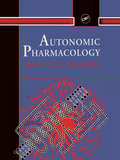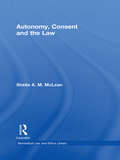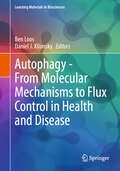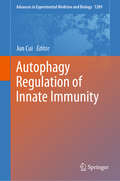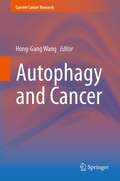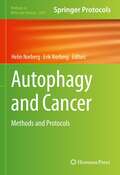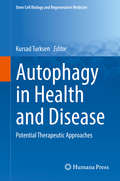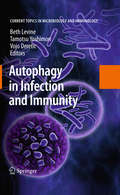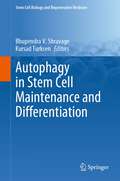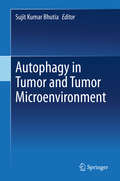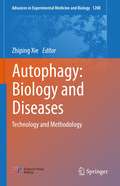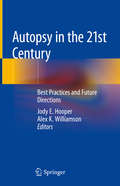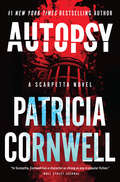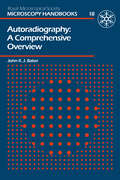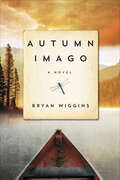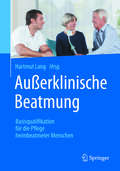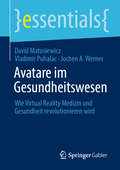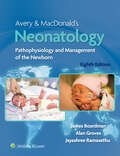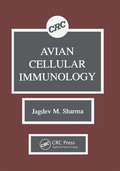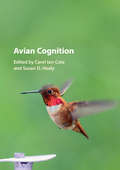- Table View
- List View
Autonomic Pharmacology
by Kenneth J BroadleyThis overview of autonomic pharmacology describes the anatomy, physiology and pharmacology of the autonomic involuntary nervous system. Covering the diverse group of drugs acting on the autonomous nervous system, their actions are reviewed together with their clinical uses, side effects, interactions and subcellular mechanisms of action. Information is organized in a logical flow, bringing together the latest advances in an integrated form on topics usually found only in a fragmented form.; This work is intended for all those researching in industry and academic institutions in pharmaceutical, pharmacological sciences, pharmacy, medical sciences, physiology, neurosciences, biochemistry and molecular biology.
Autonomie und Familie: Behandlungsentscheidungen bei geschäfts- und einwilligungsunfähigen Volljährigen (MedR Schriftenreihe Medizinrecht)
by Daniel BrauerBeiträge zur Patientenautonomie gibt es viele. Was bisher aber kaum Beachtung gefunden hat, ist das Verhältnis zwischen Patientenautonomie und der Familie als personellem Nahraum. Das vorliegende Buch schließt diese Lücke, indem es die Bedeutung von Familienangehörigen bei medizinischen Entscheidungssituationen geschäfts- und einwilligungsunfähiger Patienten untersucht. Der Autor bereitet die Thematik systematisch auf, indem er, ausgehend von einer Darstellung eines Autonomiekonzepts und den Grundlagen der medizinischen Behandlung, der Kernfrage nachgeht, wie die Familie in den Entscheidungsfindungsprozess einbezogen wird und warum. Aufbauend auf diesen Erkenntnissen untersucht der Autor, ob aus der Einbeziehung der Familie eine Gefährdung für die Autonomie des Einzelnen folgt. Abschließend wendet sich der Autor der Beteiligung von Familienmitgliedern in den Rechtsordnungen der USA und den sich aus einem Rechtsvergleich ergebenden Handlungsimpulsen für das deutsche Recht zu.
Autonomous Vehicles and Virtual Reality: The New Automobile Industrial Revolution
by Andras KemenyThis book concisely describes the technologies, human perception, and cognition issues relevant to autonomous vehicles. It also gives an insight in the changes bring about our future everyday lives.Autonomous vehicles are the future of the automobile industry. Automated driving (AD), also called self-driving, raises however several multiple questions, among them those of user safety and acceptation. Comprehensive HMI system design, with windshield display technics, will be necessary to deal with driving task delegations, bringing the use of VR or augmented reality (AR) technologies. In addition, the use of VR for all the vehicle interiors will progressively be proposed for entertainment, online business activities and for modified visual motion perception to alleviate car sickness, a form of motion sickness. Indeed, car sickness is already well known for many passengers, especially when reading or operating smartphones or other display devices. It is called to increase significantly with the introduction of autonomous vehicles where all users will be for long periods in various sitting positions. These two new trends, AD and VR, are already modifying our relationship with the world and the society. All together, they will change our way of life forever. The book will be of interest to professionals in the auto industry, researchers in automotive engineering and computer science and all those interested in the future of transport.
Autonomy and Pregnancy: A Comparative Analysis of Compelled Obstetric Intervention (Biomedical Law and Ethics Library)
by Sam HallidayTechnology has come to dominate the modern experience of pregnancy and childbirth, but instead of empowering pregnant women, technology has been used to identify the foetus as a second patient characterised as a distinct entity with its own needs and interests. Often, foetal and the woman’s interests will be aligned, though in legal and medical discourses the two ‘patients’ are frequently framed as antagonists with conflicting interests. This book focuses upon the permissibility of encroachment on the pregnant woman’s autonomy in the interests of the foetus. Drawing on the law in England & Wales, the United States of America and Germany, Samantha Halliday focuses on the tension between a pregnant woman’s autonomy and medical actions taken to protect the foetus, addressing circumstances in which courts have declared medical treatment lawful in the face of the pregnant woman’s refusal of consent. As a work which calls into question the understanding of autonomy in prenatal medical care, this book will be of great use and interest to students, researchers and practitioners in medical law, comparative law, bioethics, and human rights.
Autonomy, Consent and the Law (Biomedical Law and Ethics Library)
by Sheila A.M. McLeanAutonomy is often said to be the dominant ethical principle in modern bioethics, and it is also important in law. Respect for autonomy is said to underpin the law of consent, which is theoretically designed to protect the right of patients to make decisions based on their own values and for their own reasons. The notion that consent underpins beneficent and lawful medical intervention is deeply rooted in the jurisprudence of countries throughout the world. However, Autonomy, Consent and the Law challenges the relationship between consent rules and autonomy, arguing that the very nature of the legal process inhibits its ability to respect autonomy, specifically in cases where patients argue that their ability to act autonomously has been reduced or denied as a result of the withholding of information which they would have wanted to receive. Sheila McLean further argues that the bioethical debate about the true nature of autonomy – while rich and challenging – has had little if any impact on the law. Using the alleged distinction between the individualistic and the relational models of autonomy as a template, the author proposes that, while it might be assumed that the version ostensibly preferred by law – roughly equivalent to the individualistic model – would be transparently and consistently applied, in fact courts have vacillated between the two to achieve policy-based objectives. This is highlighted by examination of four specific areas of the law which most readily lend themselves to consideration of the application of the autonomy principle: namely refusal of life-sustaining treatment and assisted dying, maternal/foetal issues, genetics and transplantation. This book will be of great interest to scholars of medical law and bioethics.
Autophagy - From Molecular Mechanisms to Flux Control in Health and Disease (Learning Materials in Biosciences)
by Ben Loos Daniel J. KlionskyThis textbook describes the autophagy pathway with all its key molecular mechanisms and its physiological functions from yeast to eukaryotes in a didactic and reader-friendly manner. It provides the most critical aspects that need to be understood to foster research and clinical translation in this area. Autophagy activity, mechanism and control in the context of cellular fate are central to this book, underpinned by human pathologies of priority. Further, key chapters describing major techniques required to assess autophagy activity, and highlighting starting points for the research of potential drug candidates and clinical translation, offer detailed insight into practice and application. The work represents a comprehensive study guide that allows undergraduate and postgraduate students in biology and biomedicine to rapidly engage with the most critical and recent aspects of autophagy in health and its control of disease. Written in a style that may be favourable for its use in the classroom, this book can also serve as a valuable source for teaching in the biomedical and medical sciences.
Autophagy Regulation of Innate Immunity (Advances in Experimental Medicine and Biology #1209)
by Jun CuiThis book discusses novel concepts and discoveries concerning the regulation of innate immunity by autophagy and autophagy-related proteins. In the past decade, there have been major advances in our understanding of the molecular mechanisms of autophagy and its physiological functions. This book highlights emerging studies on the underlying mechanisms of autophagy regulation of innate immunity, including inflammation, antiviral immunity and anti-bacterial responses and the signaling pathways that prompt or inhibit the initiation and progression of related diseases. It also offers new ideas and strategies for future drugs based on manipulating autophagy, especially selective autophagy mediated by cargo receptors. Providing a comprehensive overview of the autophagy regulation of innate immunity, it is a valuable resource for graduate students and researchers in the fields of immunology, cell biology and translational medicine.
Autophagy and Cancer (Current Cancer Research #8)
by Hong-Gang WangWith the explosion of information on autophagy in cancer, this is an opportune time to speed the efforts to translate our current knowledge about autophagy regulation into better understanding of its role in cancer. This book will cover the latest advances in this area from the basics, such as the molecular machinery for autophagy induction and regulation, up to the current areas of interest such as modulation of autophagy and drug discovery for cancer prevention and treatment. The text will include an explanation on how autophagy can function in both oncogenesis and tumor suppression and a description of its function in tumor development and tumor suppression through its roles in cell survival, cell death, cell growth as well as its influences on inflammation, immunity, DNA damage, oxidative stress, tumor microenvironment, etc. The remaining chapters will cover topics on autophagy and cancer therapy. These pages will serve as a description on how the pro-survival function of autophagy may help cancer cells resist chemotherapy and radiation treatment as well as how the pro-death functions of autophagy may enhance cell death in response to cancer therapy, and how to target autophagy for cancer prevention and therapy -- what to target and how to target it.
Autophagy and Cancer: Methods and Protocols (Methods in Molecular Biology #2445)
by Helin Norberg Erik NorbergThis volume includes comprehensive methods and protocols on autophagic pathways in cancer disorders. Chapters cover basic principles of autophagy methodology in cancer cells, translational approaches, systematic computational analyses of TCGA (The Cancer Genome Atlas) cohorts, CCLE (The Cancer Cell Line Encyclopedia) analysis, CRISPR genetics, metabolomics, biochemistry, and immunohistochemistry methodologies. Written in the format of the highly successful Methods in Molecular Biology series, each chapter includes an introduction to the topic, lists necessary materials and reagents, includes tips on troubleshooting and known pitfalls, and step-by-step, readily reproducible protocols. Authoritative and cutting-edge, Autophagy and Cancer: Methods and Protocols aims to be a useful practical guide to researches to help further their study in this field.
Autophagy in Health and Disease: Potential Therapeutic Approaches (Stem Cell Biology and Regenerative Medicine)
by Kursad TurksenThis timely volume explores the impact of autophagy in various human diseases, emphasizing the cell biological aspects and focusing on therapeutic approaches to these diseases. The chapters cover autophagy and its potential applications on diseases ranging from obesity, osteoarthritis, pulmonary fibrosis, and inflammation, through ALS, Parkinson's, retinal degeneration, breast cancer, alcoholic liver disease and more. The final chapters round out the book with a discussion of autophagy in drug discovery and 'bench to bedside'. Chapters are contributed by leading authorities and describe the general concepts of autophagy in health and disease, marrying cell biology and pharmacology and covering: studies derived from preclinical experiments, manufacturing considerations,and regulatory requirements pertaining to drug discovery and manufacturing and production. This volume will be useful for basic scientists as well as already practicing clinicians and advanced graduate students.
Autophagy in Infection and Immunity: A Novel Immune Effector (Current Topics in Microbiology and Immunology #335)
by Vojo Deretic Beth Levine Tamotsu YoshimoriAutophagy is a fundamental biological process that enables cells to autodigest their own cytosol during starvation and other forms of stress. It has a growing spectrum of acknowledged roles in immunity, aging, development, neurodegeneration, and cancer biology. An immunological role of autophagy was first recognized with the discovery of autophagy's ability to sanitize the cellular interior by killing intracellular microbes. Since then, the repertoire of autophagy's roles in immunity has been vastly expanded to include a diverse but interconnected portfolio of regulatory and effector functions. Autophagy is an effector of Th1/Th2 polarization; it fuels MHC II presentation of cytosolic (self and microbial) antigens; it shapes central tolerance; it affects B and T cell homeostasis; it acts both as an effector and a regulator of Toll-like receptor and other innate immunity receptor signaling; and it may help ward off chronic inflammatory disease in humans. With such a multitude of innate and adaptive immunity functions, the study of autophagy in immunity is one of the most rapidly growing fields of contemporary immunological research. This book introduces the reader to the fundamentals of autophagy, guides a novice and the well-informed reader alike through different immunological aspects of autophagy as well as the countermeasures used by highly adapted pathogens to fight autophagy, and provides the expert with the latest, up-to-date information on the specifics of the leading edge of autophagy research in infection and immunity.
Autophagy in Stem Cell Maintenance and Differentiation (Stem Cell Biology and Regenerative Medicine #73)
by Kursad Turksen Bhupendra V. ShravageThis book covers a wide range of topics that illustrate the various functions of autophagy in stem cells and offers insights on the mechanisms by which autophagy can regulate stem-cell self-renewal and facilitate specific differentiation programs. Stem cells are unique cells present in most multicellular animals and are essential for their survival. They have two unique properties: the ability to self-renew and the ability to differentiate into one or more cell types. These characteristics of stem cells have found immense therapeutic potential in regenerative medicine. Autophagy is a crucial membrane trafficking pathway that is essential for maintaining cellular homeostasis that involves sequestration of non-functional proteins, protein aggregates and damaged organelles in double-membraned vesicles called autophagosomes, which are subsequently targeted to the lysosome for degradation. The primary aim of this book is to provide knowledge of recent developments in our understanding of the role of autophagy in stem cells, including germline stem cells.Autophagy is considered a promising target for many diseases. Significant efforts are being developed to identify specific modulators of autophagy, which will aid in designing combinatorial therapeutic strategies that will allow significant improvements in regenerative medicine.
Autophagy in tumor and tumor microenvironment
by Sujit Kumar BhutiaThis book deals with the paradoxical role of autophagy in tumor suppression and tumor promotion in cancer cells. Autophagy plays opposing, context-dependent roles in tumors; accordingly, strategies based on inhibiting or stimulating autophagy could offer as potential cancer therapies. The book elucidates the physiological role of autophagy in modulating cancer metastasis, which is the primary cause of cancer-associated mortality. Further, it reviews its role in the differentiation, development, and activation of multiple immune cells, and its potential applications in tumor immunotherapy. In addition, it examines the effect of epigenetic modifications of autophagy-associated genes in regulating tumor growth and therapeutic response and summarizes autophagy’s role in the development of resistance to a variety of anti-cancer drugs in cancer cells. In closing, it assesses autophagy as a potential therapeutic target for cancer treatment. Given its scope, the book offers a valuable asset for all oncologists and researchers who wish to understand the potential role of autophagy in tumor biology.
Autophagy: Clinical Science (Advances in Experimental Medicine and Biology #1207)
by Weidong LeThis book consists of 3 volumes: Basic Science (Volume 1), Clinical Science (Volume 2) and Technology and Methodology (Volume 3). Volume 2 focuses on the clinical aspects of autophagy research, discussing the role of autophagy in neuropsychiatric disorders, the cardiovascular, immune, digestive and endocrine systems, as well as tumors, infection, the kidney, and the respiratory and hematological systems. It also addresses autophagy-related drug development. Written and edited by a team of 90 experts, and presenting the state of the art in autophagy research, this book is a valuable reference resource for researchers and clinicians alike. It can also be used as supplementary material for graduate students majoring in biology and medicine
Autophagy: Technology and Methodology (Advances in Experimental Medicine and Biology #1208)
by Zhiping XieThis book series consists of 3 volumes covering the basic science (Volume 1), clinical science (Volume 2) and the technology and methodology (Volume 3) of autophagy. Volume 3 focuses on the technical aspects of autophagy research. It is comprised of two parts. The first part discusses the basic process of autophagy, including its overall classification and individual stages in the life cycle of autophagosomes. The second part discusses the tools, strategies, and model systems in current autophagy research, including cell and animal models, detection and manipulation methods, as well as screening, genomic, proteomic and bioinformatic approaches. The book is written and edited by a team of active scientists. It is intended as a practical reference resource for interested researchers to get started on autophagy studies.
Autopsy in the 21st Century: Best Practices and Future Directions
by Jody E. Hooper Alex K. WilliamsonAutopsy as a field is enjoying an unexpected renaissance as new and improved uses are found for postmortem examination in quality improvement, education, and research. Increased interest in the autopsy is evident in the popular press as well as in national and international physician meetings.This text will provide an overview of topics the authors consider crucial to competent and effective autopsy practice in the 21st century. Each chapter will combine relevant theoretical background with current and practical experience-based guidance so that pathologists and clinicians can better utilize the autopsy to provide optimal value to families, patients, hospitals, and health systems. Distinguished contributors will provide a review of the rich history of autopsy practice, including assessments of how the past both informs autopsy practice and impedes its progress. The autopsy will be placed in the context of larger healthcare systems with chapters on the use of autopsy in quality improvement and evaluating the value of autopsy as a professional activity, as well as new technology that affects practice models. Better and more reproducible methods for reporting autopsy findings will be explored to exploit the full potential of autopsy data for cross-institutional research. Two chapters will also provide the first book-level review of the growing field of autopsies performed on an urgent basis to sample both diseased and normal control tissue for research. These “rapid research autopsies” are especially crucial to cancer research and the growth of personalized medicine, and the book will explain the science behind utilization of autopsy tissue and offer a full template for designing and delivering a successful rapid autopsy program. Additionally, pathologist and clinician contributors will highlight current recommendations for special techniques and ancillary testing in postmortem examinations to serve the needs of today’s patient populations. As resident education is re-examined by pathology and education authorities, new competency-based training models will almost certainly come to the fore. A chapter will examine approaches to the future training of medical students, residents, and fellows in an environment of changing autopsy exposure. A final chapter will summarize the vision for the autopsy as a clinical outcome measure, and valuable scientific resource. This book will be a new type of volume in the field of autopsy pathology. It differs from the presently available review references and atlases in that it provides guidance for readers to embrace transformations that are already taking place in the field. There currently is no resource that offers comprehensive guidance for modern autopsy practice and looks forward to what the field might become in the future.
Autopsy: A Scarpetta Novel (Kay Scarpetta #25)
by Patricia CornwellNew York Times BestsellerIn this relaunch of the electrifying, landmark #1 bestselling thriller series, chief medical examiner Dr. Kay Scarpetta hunts those responsible for two wildly divergent and chilling murders. Forensic pathologist Dr. Kay Scarpetta has come almost full circle, returning to Virginia, the state where she launched her storied career, as the chief medical examiner. Finding herself the new girl in town once again after being away for many years, she’s inherited both an overbearing secretary and a legacy of neglect and potential corruption.She and her husband, Benton Wesley, now a forensic psychologist with the U.S. Secret Service, have relocated to Old Town Alexandria, where she’s headquartered five miles from the Pentagon in a post-pandemic world that’s been torn apart by civil and political unrest. After just weeks on the job, she’s called to a scene by railroad tracks—a woman’s body has been shockingly displayed, her throat cut down to the spine—and as Scarpetta begins to follow the trail, it leads unnervingly close to her own historic neighborhood. At the same time, a catastrophe occurs in a top secret laboratory in outer space, endangering at least two scientists aboard. Appointed to the highly classified Doomsday Commission that specializes in sensitive national security cases, Scarpetta is summoned to the White House and tasked with finding out exactly what happened. But even as she remotely works the first potential crime scene in space, an apparent serial killer strikes again very close to home.This latest novel in the groundbreaking Kay Scarpetta series captivates readers with the shocking twists, high-wire tension, and forensic detail that Patricia Cornwell is famous for, proving once again why she’s the world’s #1 bestselling crime writer.
Autoradiography
by John R.J. BakerThis book describes levels of autoradiography, which is the localization within a solid specimen of a radiolabel, to help the beginner or biologist choose the correct approach for particular application. It attempts to lay emphasis on certain aspects of the appraisal of autoradiographs.
Autumn Imago: A Novel
by Bryan WigginsAn unexpected reunion at a remote lakeside camp in the Maine woods offers the possibility of reconciliation and healing for a man and his fractured family.For years, Paul Strand has been estranged from his family. But when his mother’s escalating Alzheimer’s disease creates a crisis that calls him home, he’s pressured into hosting a reunion he’s avoided for decades in the one place he thought his family would never return to: the rural state park in Maine where his little sister drowned years before on a family vacation.Over the course of ten days of guiding his family over difficult terrain, Paul finds himself torn between his desire for isolation and the need to reconnect with the only people who can make him whole. But after a lifetime of separation, is the painful chasm between them—and within Paul’s own soul—too deep to overcome?In this poignant spiritual novel that echoes the emotional resonance of The Glass Castle and Running with Scissors, Bryan Wiggins beautifully illuminates the mysterious power of the wilderness and the resiliency of the human spirit to heal in the wake of devastating trauma.
Außerfamiliäre Betreuung von Kleinkindern: Bindungstheoretische Hinweise für Therapeuten, Pädagogen und Pädiater (essentials)
by Martina Zemp Guy Bodenmann Peter ZimmermannDieses essential beleuchtet den aktuellen Kenntnisstand zur Inanspruchnahme öffentlicher Kindertagesbetreuung aus bindungstheoretischer Sicht. Es gibt Fachpersonen, die mit Familien arbeiten, einen Überblick und praktische Hinweise zum Thema. Die wissenschaftlichen Befunde zur Frage, ob die Betreuung in Kinderkrippen/Kitas negative Auswirkungen auf die kindliche Entwicklung hätte, sind inkonsistent. Die Folgen hängen von diversen Faktoren ab, u.a. von der Quantität und Qualität der außerfamiliären Betreuung und insbesondere von der Fürsorge und Feinfühligkeit der Eltern zu Hause. Bei guter Fürsorge kann die Eltern-Kind-Bindung aufrechterhalten werden. Dennoch ist die familienexterne Betreuung von Kleinkindern bindungstheoretisch nicht immer unproblematisch. Die Grundannahmen der Bindungstheorie bleiben in diesem Diskurs unumstritten und weiterhin hoch relevant.
Außerklinische Beatmung
by Hartmut LangSicher im Umgang mit Patient und Gerät in der Heimbeatmung!Dieses Buch bietet alle relevanten Inhalte der Weiterbildung „Basisqualifikation außerklinische Beatmung“ und richtet sich an Pflegende und Betreuer, die beatmete Menschen zu Hause oder im Pflegeheim versorgen. Lernen Sie umfassende Grundlagen zur Anatomie, Krankheitslehre und den verschiedenen Beatmungsformen und profitieren Sie vom Erfahrungsschatz der Autoren. Leicht verständlich und auf den Punkt gebracht lesen Sie hier, wie Sie Ihre Patienten oder Bewohner rundum kompetent versorgen und souverän mit der Beatmungssituation umgehen. Ideal für alle Mitarbeiter und Pflegedienste um sich für die herausfordernde Pflege beatmeten Patienten weiterzubilden und zu qualifizieren!
Avatare im Gesundheitswesen: Wie Virtual Reality Medizin und Gesundheit revolutionieren wird (essentials)
by David Matusiewicz Vladimir Puhalac Jochen A. WernerIn Zukunft werden wir mit unserem eigenen Avatar mit dem behandelnden Arzt im Smart Hospital sprechen können – und das vom Wohnzimmer aus. Das klingt utopisch, ist allerdings schon Realität geworden. Das essential beschäftigt sich mit der Frage, welchen Effekt Virtual Reality und die Avatare im Gesundheitswesen, der Medizin und in der Psychologie haben werden. Durch die praktische Erfahrung der Autoren können tiefgreifende Einblicke in eine exponentielle Technologie gegeben werden.
Avery & MacDonald's Neonatology: Pathophysiology and Management of the Newborn
by Jayashree Ramasethu James Boardman Alan GrovesFor more than 45 years, Avery & MacDonald’s Neonatology has been the premier text on the pathophysiology and management of both preterm and full-term neonates, trusted by neonatologists, neonatology fellows, pediatricians, neonatal nurse practitioners, and ob/gyn practitioners worldwide. Continuing the tradition of excellence established by Drs. Gordon B. Avery and Mhairi G. MacDonald, this fully revised eighth edition features three new lead editors, numerous new chapters, reorganized and updated content, and an increased focus on global neonatology.
Avian Cellular Immunology
by JagdevM. SharmaKnowledge regarding avian cellular immunity has expanded rapidly within the last few years and new information continues to accumulate. It is now a well-established fact that cell-mediated immunity plays a major role in the defense against neoplastic and non-neoplastic diseases in chickens. The principle objective of Avian Cellular Immunology is to compile the latest information available on various aspects of avian cellular immunity. The book contains chapters written by leading experts in the field and covers topics including cell surface markers, T-cell immunity, natural immune functions, the role of macrophages in cellular immune functions, cellular immune suppression and tolerance, cellular immune systems in avian species other than chickens, the role of cellular immunity in neoplastic and non-neoplastic viral diseases, cell-mediated immune mechanisms in bacterial and parasitic infections, and autoimmune disorders.
Avian Cognition
by Susan D. Ten Cate Carel HealyThe cognitive abilities of birds are remarkable: hummingbirds integrate spatial and temporal information about food sources, day-old chicks have a sense of numbers, parrots can make and use tools, and ravens have sophisticated insights in social relationships. This volume describes the full range of avian cognitive abilities, the mechanisms behind such abilities and how they relate to the ecology of the species. Synthesising the latest research in avian cognition, a range of experts in the field provide first-hand insights into experimental procedures, outcomes and theoretical advances, including a discussion of how the findings in birds relate to the cognitive abilities of other species, including humans. The authors cover a range of topics such as spatial cognition, social learning, tool use, perceptual categorization and concept learning, providing the broader context for students and researchers interested in the current state of avian cognition research, its key questions and appropriate experimental approaches.
